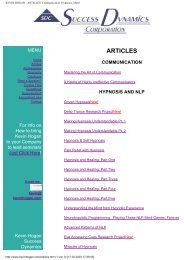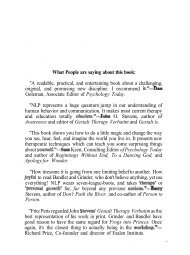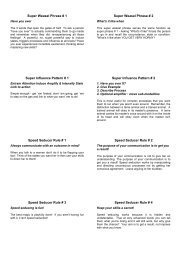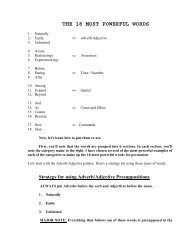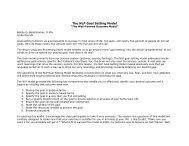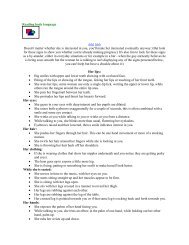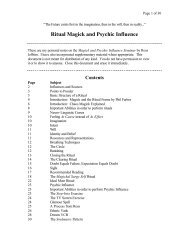A Pragmatic Guide To Communication & Change.pdf - NLP Info Centre
A Pragmatic Guide To Communication & Change.pdf - NLP Info Centre
A Pragmatic Guide To Communication & Change.pdf - NLP Info Centre
- No tags were found...
Create successful ePaper yourself
Turn your PDF publications into a flip-book with our unique Google optimized e-Paper software.
such contain all the limitations inherent in any model. Use them when and where they<br />
apply, and discard them whenever they don't fit.<br />
attention from the representational system in which they make the most distinctions.<br />
The other systems simply fail to provide information in ways that are as easily utilized<br />
by them as the information which matches their preferred system.<br />
There is another difficulty which arises when someone with the look-to-listen rule also<br />
believes that if someone looks away while speaking, it means that he is lying.'° 3 In the<br />
situation illustrated above, if the child is not operating out of the visual system, he may<br />
find it difficult to talk while looking directly at the adult. Again, due to the visual<br />
distraction, the child might have trouble "thinking" in his habitual system without<br />
looking away." This could create dire consequences if the adult thinks the child is lying<br />
because he keeps looking away.<br />
In Chapter I a somewhat different eye-contact rule was discussed regarding social<br />
constraints (see page 34). In that example, it was demonstrated how a lack of knowledge<br />
or understanding of the social rule governing direct eye contact could lead to conflict<br />
between individuals from different social backgrounds. It is important to recognize that<br />
differences also exist between individuals in a homogeneous social group. This is<br />
because people tend to orient themselves to aspects of experience that correlate to their<br />
preferred representational systems. When you can identify these differences between<br />
people, you can more easily "tune in to," "see clearly," and "connect" with other people's<br />
models of the world. This is one of those "magical" qualities of very effective<br />
communicators. By identifying and then using these differences, you will run less of a<br />
risk of making the mistake of judging another's behavior solely by the stand ards of your<br />
own model. You can more easily "bridge the gap" between yourself and your clients,<br />
students, co-workers, and anyone else with whom it is important for you to<br />
communicate.<br />
62<br />
Satir Categories<br />
The following behavioral patterns come from an unusually gifted people helper,<br />
Virginia Satin In her book, Peoplemak<br />
63<br />
ing, Satir identities four "postural stances" that people often take during the<br />
communication process.' i In their exaggerated form, says Satir, ". . . so exaggerated that<br />
nobody could miss it," (p. 63) these stances form the Satir Categories, so called after the<br />
works of Bandler and Grinder. , ' These postures are associated with the communication<br />
categories as follows.<br />
Under stress, visual representers tend to take on the postural characteristics of Satir's<br />
"blamer." That is, they take on an aggressive stance, pointing their fingers at the person<br />
they are talking to and using expressions like: "You always do that. Why can't you do<br />
anything right?" (A more complete presentation of word-patterns used by each of the<br />
communication categories is given in the next chapter.)<br />
People who are operating as "kinos" assume the "placeter" stance, especially under<br />
stress. Satir pictures a person down on one knee, hands turned palms-up as if "begging for<br />
forgiveness." Phrases associated with this posture are: "I feel so bad about making you<br />
mad at me. I just can't do anything right. Please forgive me."



